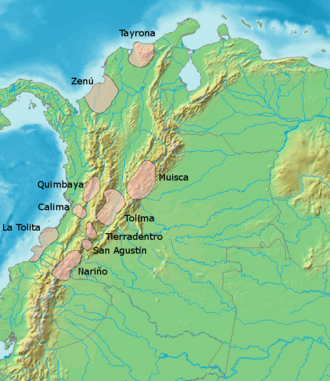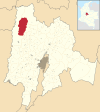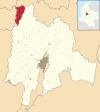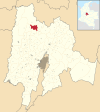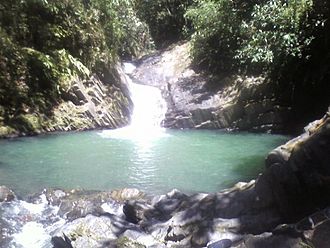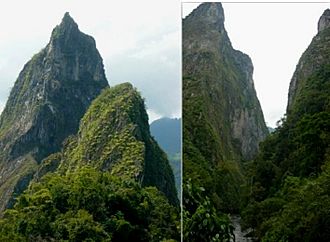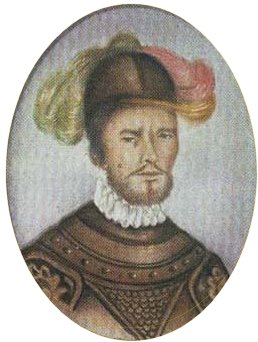Muzo people facts for kids

Flag
|
|
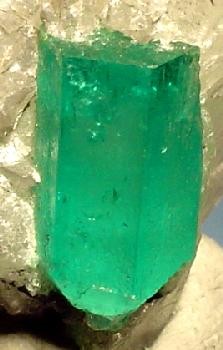
An emerald from Muzo;
The Muzo were known as the "Emerald People" |
|
| Total population | |
|---|---|
| 100,000 (including Colima) | |
| Regions with significant populations | |
| Boyacá, Cundinamarca, |
|
| Languages | |
| Cariban, Colombian Spanish | |
| Religion | |
| Traditional religion, Catholicism | |
| Related ethnic groups | |
| Guane, Lache, Muisca, Panche |
The Muzo people were an ancient group from Colombia. They spoke a language from the Cariban family. They lived on the western side of the Andes mountains. The Muzo were known for being brave warriors. They often had conflicts with other groups nearby, especially the Muisca.
The Muzo lived near the Magdalena River. This was in the lower parts of western Boyacá and Cundinamarca. They were called the "Emerald People." This is because they mined many emeralds in their land, especially in the area known as Muzo. When the Spanish arrived, the Muzo fought back strongly. It took the Spanish about twenty years to finally take control of their land.
We know about the Muzo people from old writings. These writings were made by historians like Gonzalo Jiménez de Quesada, Pedro Simón, Juan de Castellanos, and Lucas Fernández de Piedrahita.
Contents
Where Did the Muzo People Live?
The Muzo people lived in the lower, northwestern parts of the Cundinamarca department. They also lived in the western part of the Boyacá Department. This area was closer to the Magdalena River.
Their neighbors to the north were the Naura people. To the south were the Panche. To the southeast, the Muisca lived in the higher Altiplano Cundiboyacense region. The Colima people were their neighbors to the west.
Many believe the Muzo were the first people to live in Boyacá. They originally came from a place called Saboyá. Their land stretched from the thick forests near the Carare River in the north. This was at the border with Santander. In the south, their land reached the Río Negro. To the east, it went to the Pacho River and the Ubaté-Chiquinquirá Valley. The Magdalena River formed their western border. Some sources say the Muzo area was between the Sogamoso, Suárez, Magdalena, and Ermitaño rivers.
Towns in Muzo Territory
Many modern towns are located in what used to be Muzo lands. Here are some of them:
| Name | Department | Elevation (m) urban centre |
Map |
|---|---|---|---|
| Coper | Boyacá | 950 | |
| Maripí | Boyacá | 1249 | |
| Muzo | Boyacá | 815 | |
| Otanche | Boyacá | 1050 | |
| Quípama | Boyacá | 1200 | |
| Puerto Boyacá | Boyacá | 145 | |
| San Pablo de Borbur | Boyacá | 830 | |
| Tununguá | Boyacá | 1246 | |
| Caparrapí | Cundinamarca | 1271 | |
| Paime | Cundinamarca | 960 | |
| Puerto Salgar | Cundinamarca | 177 | |
| San Cayetano | Cundinamarca | 2700 | |
| Topaipí | Cundinamarca | 1323 |
What Were the Muzo Like?
The Muzo were strong warriors. They lived relatively short lives. Their good health may have come from their vegetarian diet. They always built their homes near waterfalls or springs. The hot climate made them sweat a lot, so they bathed often. Muzo parents named their children after trees, animals, and plants.
The Muzo people were skilled in many ways. They practiced farming, worked with wood, and made ceramics. But they were most famous for mining emeralds. For a long time, Muzo was known as the world capital for these green gemstones.
Muzo society had different groups. There were warriors, higher-ranking people, and chingamanas or chingamas. They also had slaves, usually people captured from other tribes. The oldest and bravest members were very important. However, they were not called caciques (chiefs). We don't know much about their specific laws. For hunting and fighting, they used poisoned arrows. This was common for many native tribes in South America. The poison, called curare, came from plants and even poisonous frogs.
Muzo Religion
The Muzo people had a few main gods. Their creator god was named Are. This god was similar to the Muisca god Chiminigagua. Maquipa was the god who healed illnesses. The Muzo also worshipped the Sun and the Moon. Unlike some other groups, the Muzo people did not build temples.
The Sacred Mountains: Fura and Tena
The two mountain peaks, Fura and Tena, were very special to the Muzo. They believed these mountains were the parents of all humanity. They thought Are created them. Fura and Tena taught the Muzo how to farm, make crafts, and fight wars.
There is a myth about Furatena. It tells of a man with blue eyes and a blonde beard named Zarbi. He came to Muzo lands looking for the Fountain of Youth. He met the beautiful Fura and they fell in love. Fura's husband, Tena, was very angry. He killed Zarbi. Then, he killed Fura and died himself. From their deaths, the two mountain peaks were formed. Muzo legends say that Fura's tears turned into emeralds and butterflies.
The Muisca people sometimes made secret trips to Fura and Tena. They had to avoid the Muzo warriors who tried to stop them. A historian named Lucas Fernández de Piedrahita wrote about a female chief, a cacica, named "Furatena." She owned the most beautiful emeralds in Muzo territory. Early in the Spanish conquest, the zipa (Muisca ruler) Sagipa wanted to meet Furatena.
The Emerald People's Riches
The Spanish first learned about emeralds in Colombia in 1514 in Santa Marta. During the journey of Gonzalo Jiménez de Quesada, the Spanish found emeralds from the Eastern Ranges in 1537. This happened in Chivor with Pedro Fernández de Valenzuela and Antonio Díaz de Cardoso. During the Spanish conquest of the Muisca, explorers heard about the emeralds from Muzo. In 1544, Diego Martínez found the famous Muzo mines.
While there are different stories about silver, copper, iron, and gold in the region, everyone agrees on the emeralds. To get the emeralds out of the rock, the Muzo used sharp wooden poles called coa. They used water to clean the areas where the minerals were found. After mining, the Muzo people shaped and worked with the emeralds.
Before the Spanish arrived, the Muzo and Muisca often fought. The Muzo hid their emeralds from their eastern neighbors. The Muisca ruler, zipa Tisquesusa, even entered Muzo land. He killed a leader to try and find out where the emeralds were hidden.
Muzo History
It is thought that around 1000 AD, the Muzo people pushed the Muisca eastward. The Muisca had originally lived in the lower lands. The Muzo then took over the Muisca's religious centers.
Spanish Conquest of the Muzo
The Spanish had a very hard time conquering the Muzo in the 1500s. The Muzo fought bravely against the Spanish soldiers. Their land had many creeks and deep valleys, which made it difficult for Spanish horses. The Muzo used the natural landscape as hiding places and forts.
In 1552, the conquistador Pedro de Ursúa started a new city called Tudela near Muzo territory. But the Muzo people attacked it and destroyed the settlement. They forced the Spanish to retreat.
The conquistador who finally brought the Muzo under Spanish rule was Luis Lanchero. He was a captain in the army of Nikolaus Federmann. His first attempt in 1539 with 40 men failed. But he succeeded about twenty years later, in 1559 or 1560. He founded a town called Santísima Trinidad de los Muzos. This is where the modern town of Muzo is today, built on the ruins of Tudela. During his second campaign, Lanchero was almost killed by a poisoned arrow from the Muzo.
Key Dates of Conquest by Luis Lanchero
| Settlement | Department | Date | Year | Notes | Map |
|---|---|---|---|---|---|
| Muzo | Boyacá | 1539 | |||
| Coper | Boyacá | 1540 | |||
| Pauna | Boyacá | 1540-41 | |||
| Quípama | Boyacá | 1541 | |||
| Maripí | Boyacá | 1559 |
See also
 In Spanish: Muzos para niños
In Spanish: Muzos para niños
- Muisca people
- Luis Lanchero
- Guane, Lache, Panche, Sutagao
- Colombian emeralds


